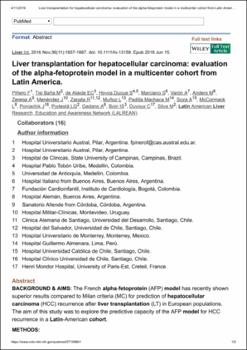| dc.description.abstract | BACKGROUND & AIMS:
The French alpha-fetoprotein (AFP) model has recently shown superior results compared to Milan criteria (MC) for prediction of hepatocellular carcinoma (HCC) recurrence after liver transplantation (LT) in European populations. The aim of this study was to explore the predictive capacity of the AFP model for HCC recurrence in a Latin-American cohort.
METHODS:
Three hundred twenty-seven patients with HCC were included from a total of 2018 patients transplanted at 15 centres. Serum AFP and imaging data were both recorded at listing. Predictability was assessed by the Net Reclassification Improvement (NRI) method.
RESULTS:
Overall, 82 and 79% of the patients were within MC and the AFP model respectively. NRI showed a superior predictability of the AFP model against MC. Patients with an AFP score >2 points had higher risk of recurrence at 5 years Hazard Ratio (HR) of 3.15 (P = 0.0001) and lower patient survival (HR = 1.51; P = 0.03). Among patients exceeding MC, a score ≤2 points identified a subgroup of patients with lower recurrence (5% vs 42%; P = 0.013) and higher survival rates (84% vs 45%; P = 0.038). In cases treated with bridging procedures, following restaging, a score >2 points identified a higher recurrence (HR 2.2, P = 0.12) and lower survival rate (HR 2.25, P = 0.03). A comparative analysis between HBV and non-HBV patients showed that the AFP model performed better in non-HBV patients.
CONCLUSIONS:
The AFP model could be useful in Latin-American countries to better select patients for LT in subgroups presenting with extended criteria. However, particular attention should be focused on patients with HBV. | en_US |


